Modern Art 312 Exam 2
1/34
There's no tags or description
Looks like no tags are added yet.
Name | Mastery | Learn | Test | Matching | Spaced |
|---|
No study sessions yet.
35 Terms
Fauvism
- Derain, Dufy, Matisse, and Vlaminck
- first avant garde movement of 20th cent
- critic called them Les Fauves (wild beasts)because of vivid color & wild brushstrokes
- influenced by Post-Impressionism's focus on pure color and emotional expression
- influenced by Impressionist's focus on nature, but opposed to their naturalism
- painted together, often en plein air(outdoors)
- african art used, seen as mark of originality
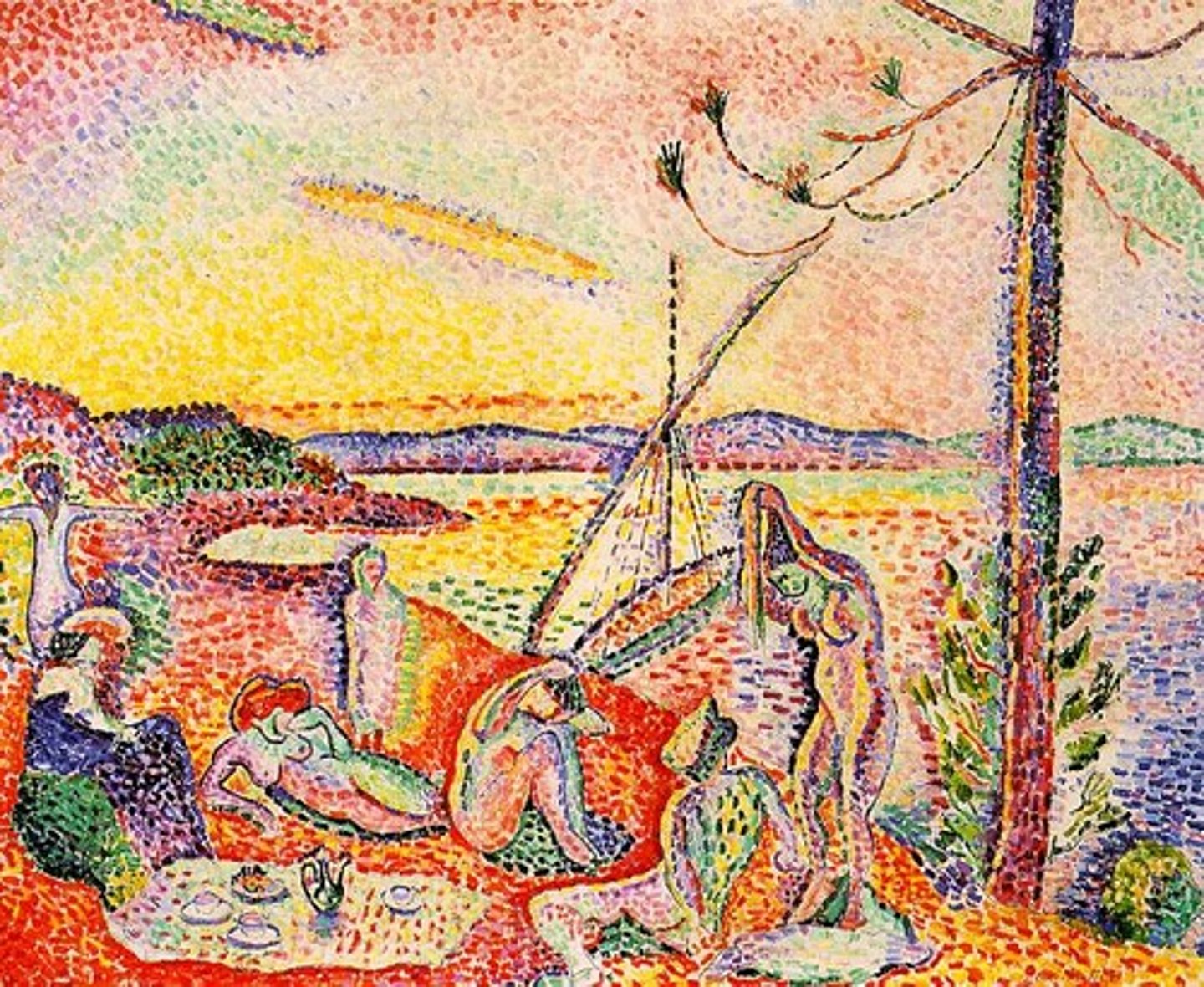
Henri Matisse, Luxe, calme et volupté
- Fauvism
- Inspired by Pointilism by Seurat
- subject matter: bathers by seaside
- Arcadia, French art tradition, humans existing in nature, golden age
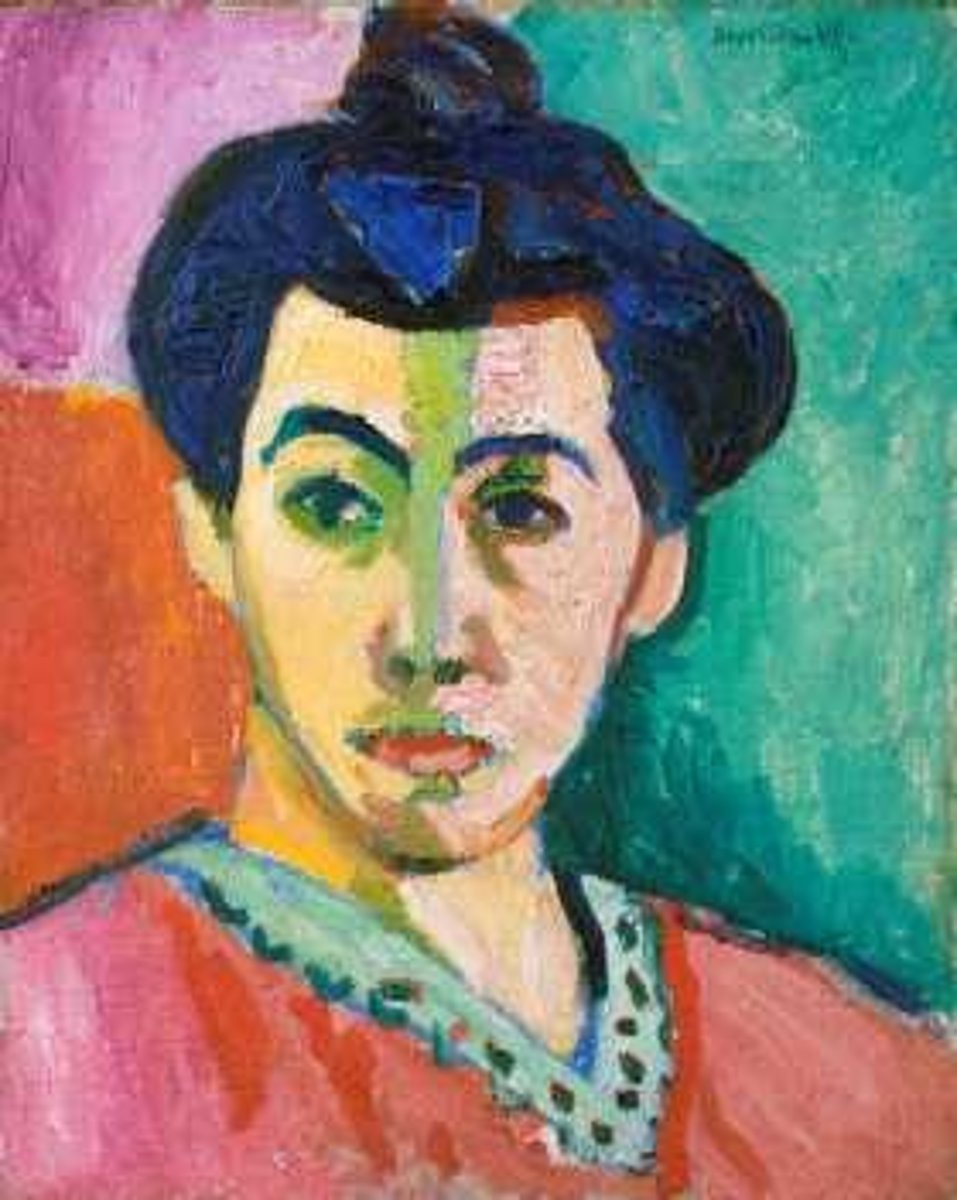
Henri Matisse, Portrait of Madame Matisse/The GreenLine
- fauvism
- color is fauvism, unnatural expressionist color
- african mask, planar face
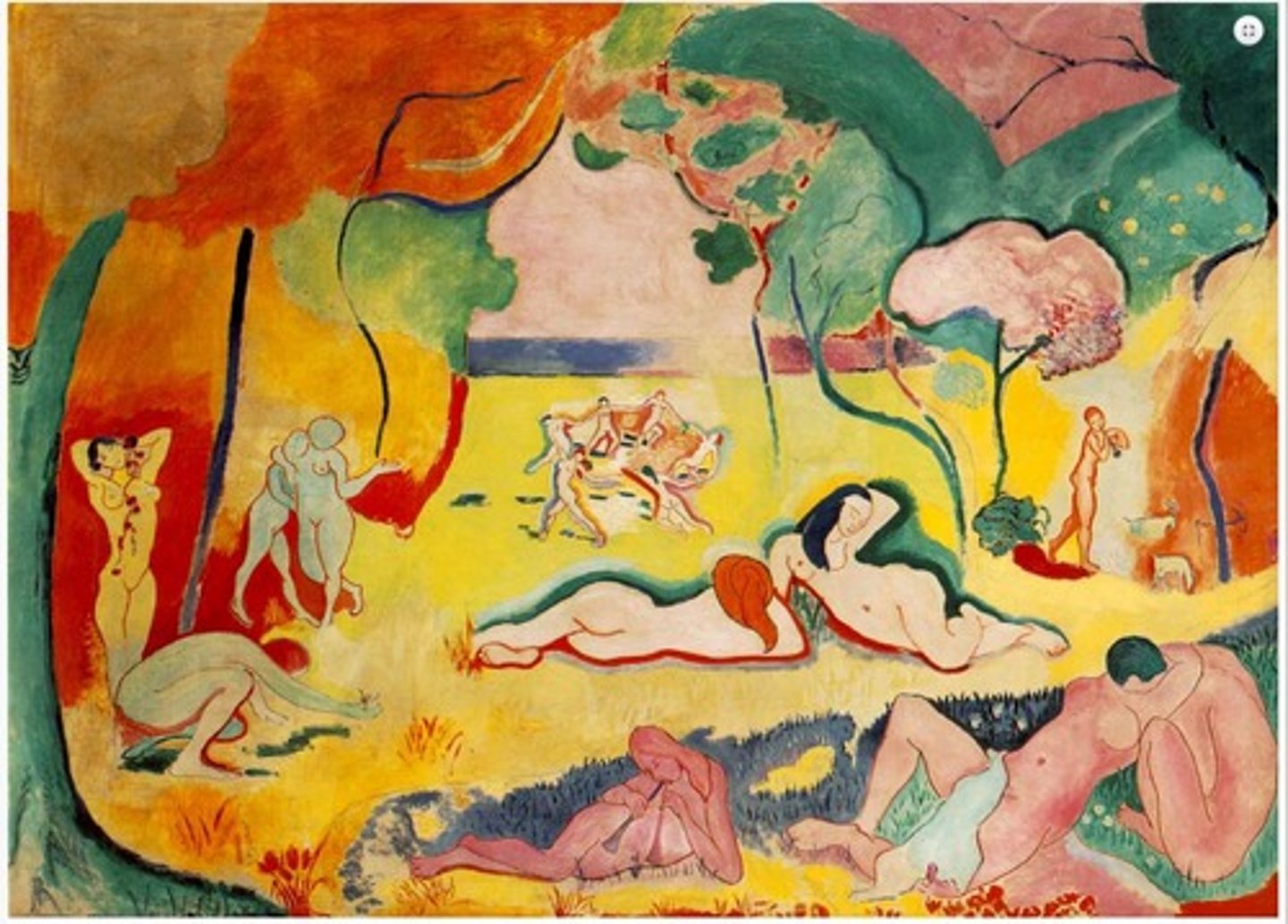
Henri Matisse, The Joy of Life
- intense, strong emotion, not realistic
- Fauvism
- arcadia, French art tradition, distant past where humans are in harmony with nature, pastoral landscape, Shepard and sheep, serenity, golden age and harmony
- contrasts with reality of industrialization, difficult time
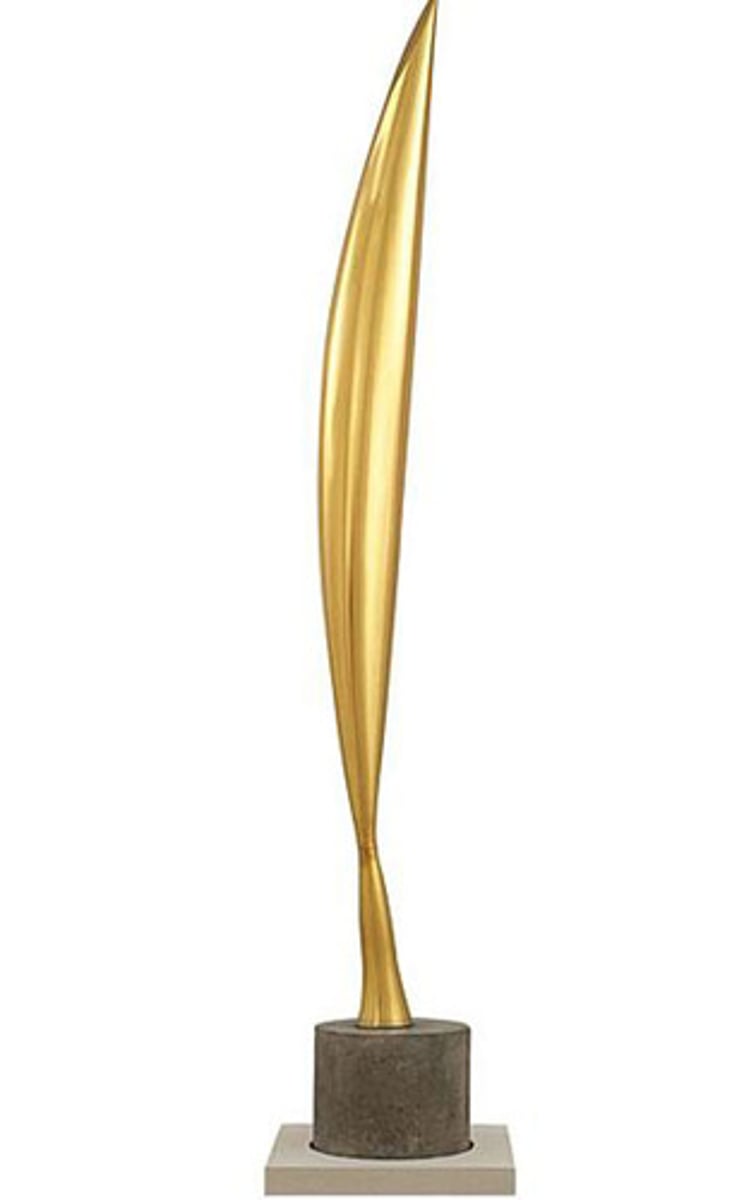
Constantin Brancusi, Bird in Space
- no movement
- first known abstract sculpture, raised question of what should be defined as art, was not allowed into U.S. because it was non-representational sculpture, how is it a bird?
- depicts essence of flight
- upward moving form, sense of a wing of feather
- base part of Brancusi's philosophy of land and sky
German Expressionism, The Bridge
- Fritz Bley, Erich Heckel, Ernst Kirchner, and Karl Schmidt-Rotluff
- Emil Nolde briefly joined
- group of architecture students turned to painting, began in Dresden, then Berlin
- personal & national identity closely tied
- Munch, Van Gogh & Gaugin's expressionism influential—technique & emotional content
- revered (highly respected) Medieval woodcuts &printmaking
- African & Oceanic cultures inspired group
- nudes in nature major theme, but tension between humanity & nature often shown over harmony
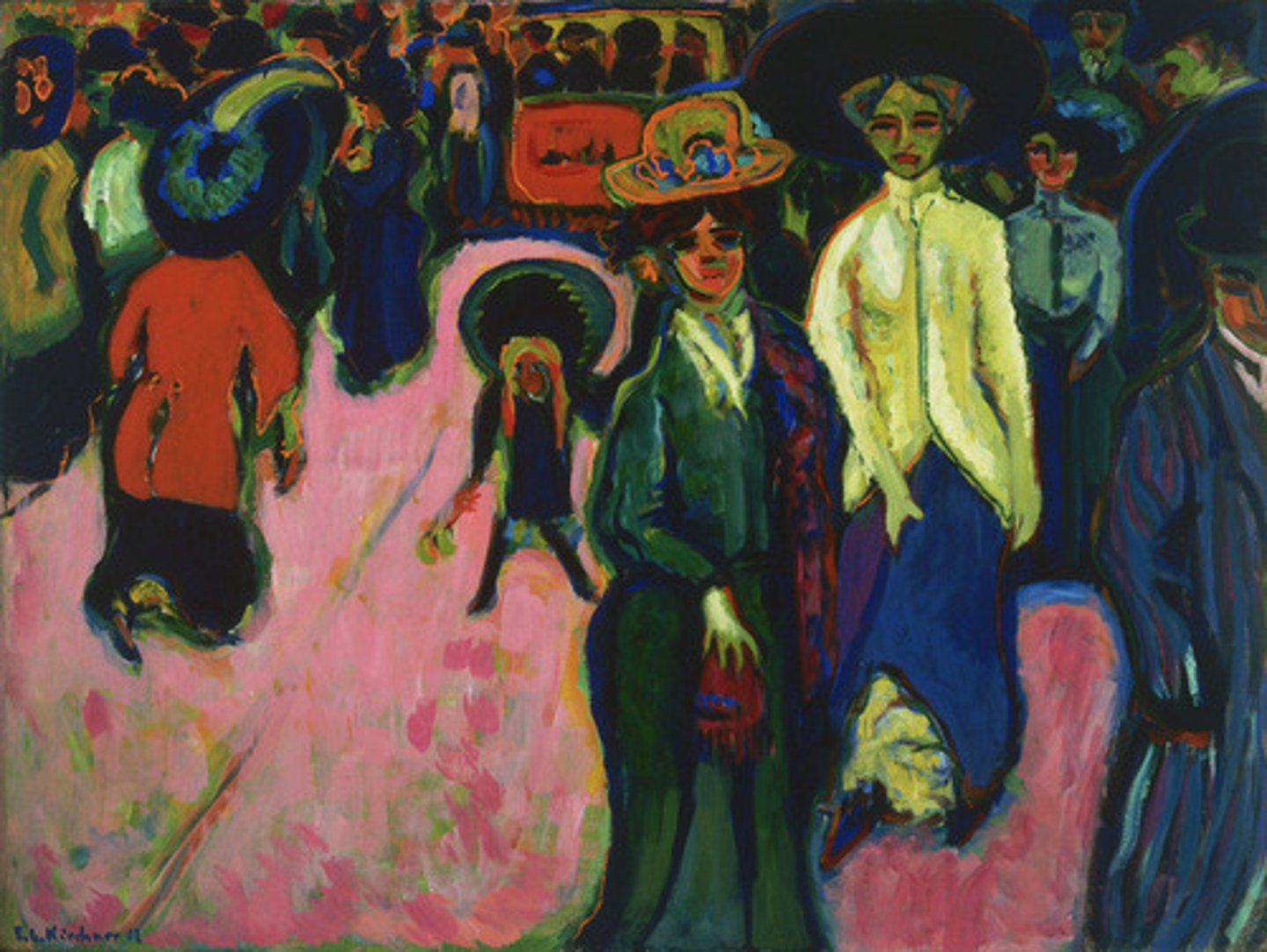
Ernst Ludwig Kirchner, Street, Dresden
- German expressionism, the bridge
- city life of Dresden
- urban anxiety and alienation, sense of lost in the crowd
- color, unnatural colors, strong feeling
- group called "the bridge" (official & organized group)
- a bridge to all that is revolutionary
- industrialization, capitalism, etc. all affected by WWI
- Kirchner came back after war with PTSD, committed suicide
- fluorescent colors used
- picture he painted is of a over-populated street
- no one is communicating, all are in they own zone, alienation of modern life
- expressionism = artists using form the express their inner meaning
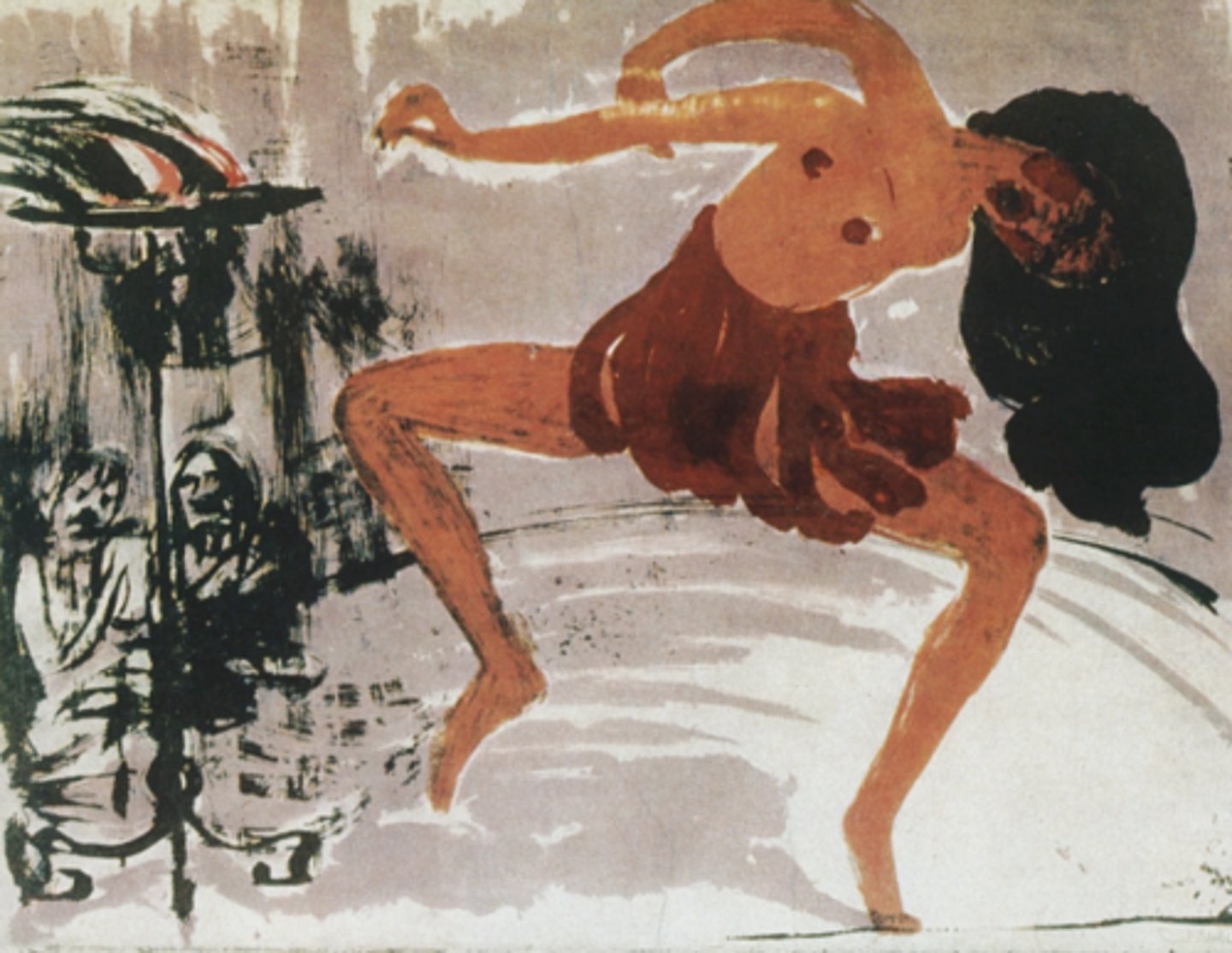
Emil Nolde, Female Dancer
- German expressionism, the bridge
- primitivist: female body in nature, people from other culture, Nolde thinks he is showing powerful sexual nature of dance, European perspective of what another culture is like
- sexuality of female, The Bridge
- Nolde is in military and imposing his notion of what the native population/female body is; colonizing; objectifying
German Expressionism, Blue rider
- Kandinsky, Franz Marc, and Gabriele Munter
- Based in Munich, under leadership of painter Vasily Kandinsky
- unlike The Bridge's more aggressive color and deformed shapes, The Blue Rider wanted art to reveal the spiritual side of reality
- like The Bridge, Blue Rider artists inspired by emotions• Kandinsky's book, Concerning the Spiritual in Art (1911), states artists should separate from material concerns of society and follow an "inner necessity" & expressing inner emotions• Kandinsky saw painting as similar to music—both are abstract forms that stir the soul. He titled many of his works "Composition" and "Improvisation"
-synesthesia (or "joined perception"): Kandinsky saw colors when he heard music & heard music when he painted

Wassily Kandinsky, Composition VII
- Der Blaue Reiter/German Expressionism.
- references music, music is another language
- spirituality
- non-objective art, purely abstract, no reference to recognizable forms
- there is another level beyond, spiritual connection, a higher order that abstract can bring humans to
- color and form express human emotion
- mystical languages, a way to convey
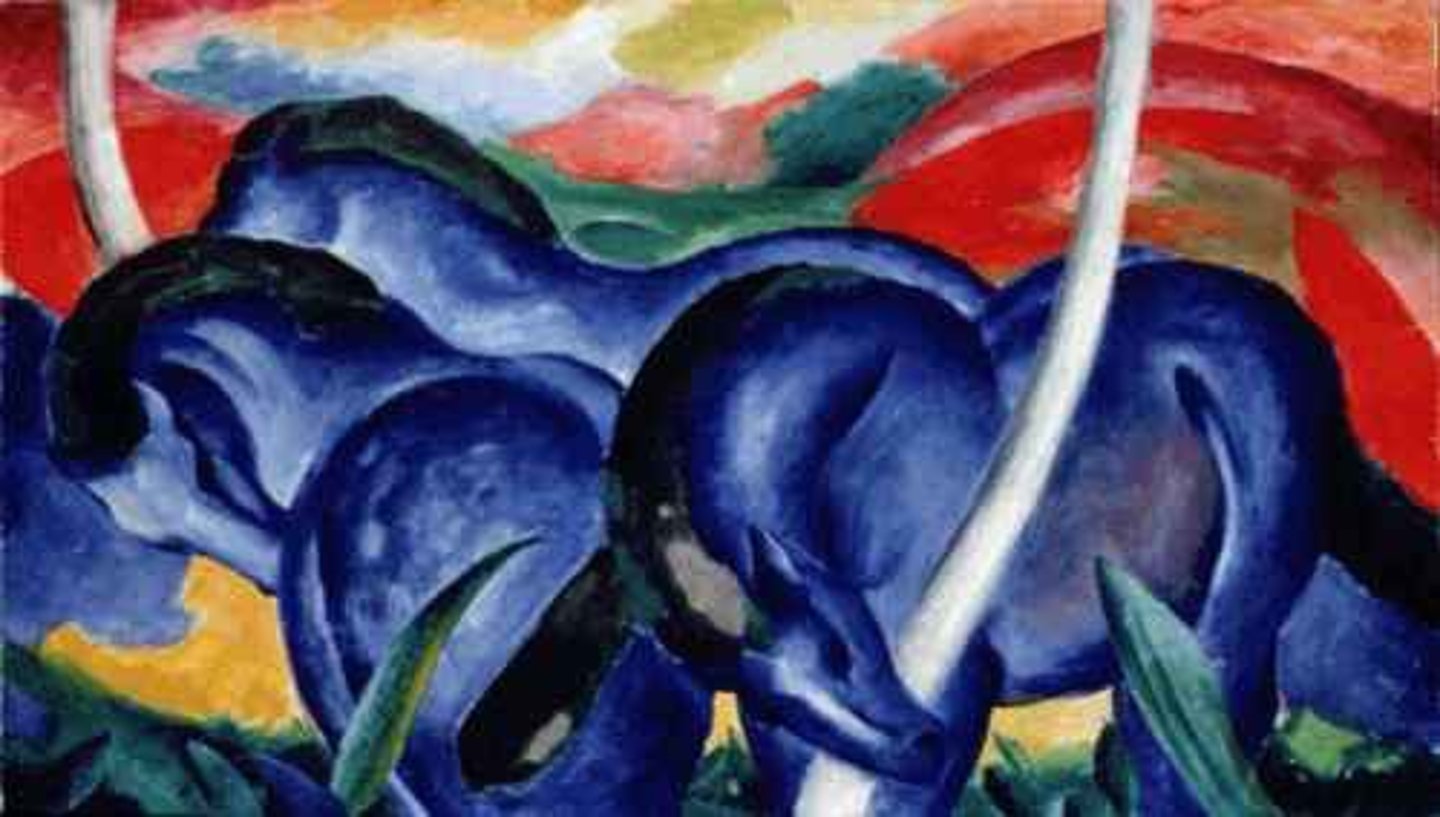
Franz Marc, The Large Blue Horses
German Expressionism (The Blue Rider)
- blue is masculine and spiritual, yellow is feminine
- color is evoking feeling and spirituality
- animals have a purity and communion with nature that humanity has lost
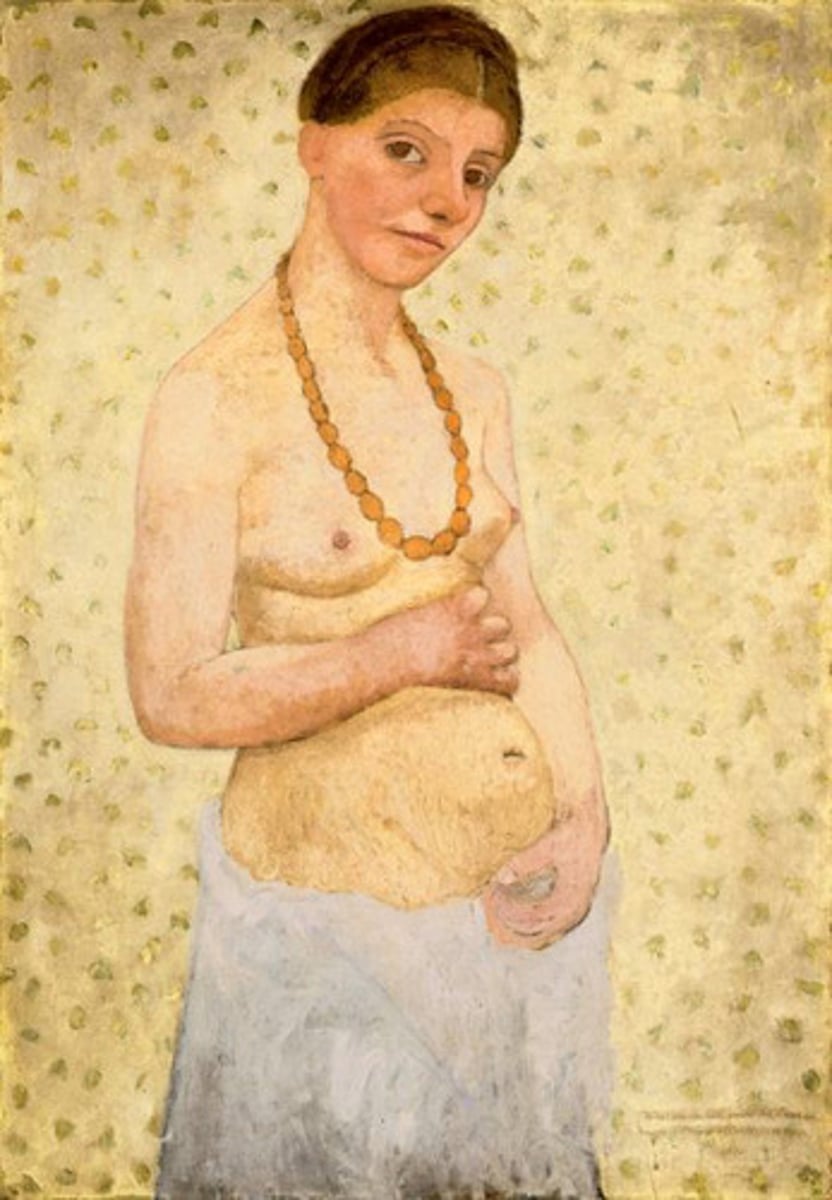
Paula Modersohn-Becker, Self-Portrait at 6th Wedding Anniversary
- German expressionism
- first self portrait of pregnant woman
- expressionist because it evokes a feeling, intimate and sweet moment
- engaging with the viewer
- it is modern because it is a woman painter painting her own naked body
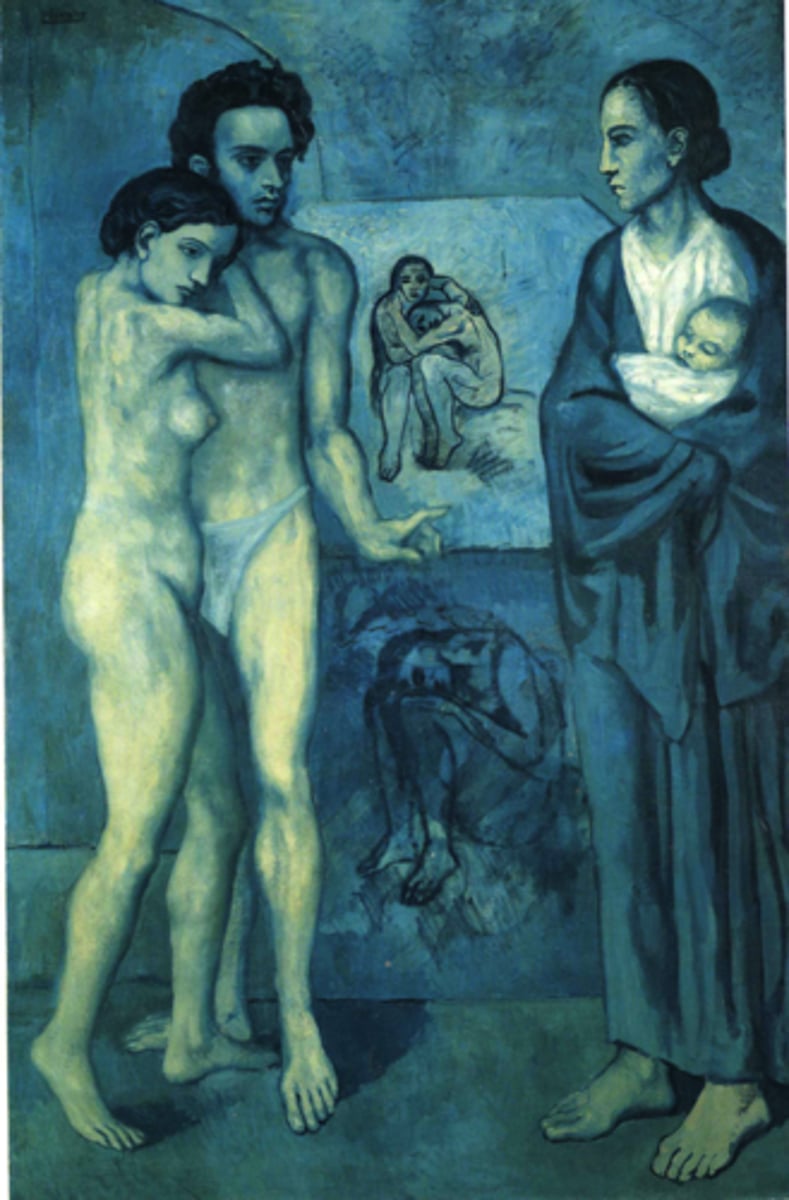
Picasso Blue Period
- blue color palette
- misery, pain, and poverty
- shows marginalized population: beggars, drunks, prostitutes
- El Greco influence, Spanish mannerist/late Renaissance
- Picasso was poor and homesick
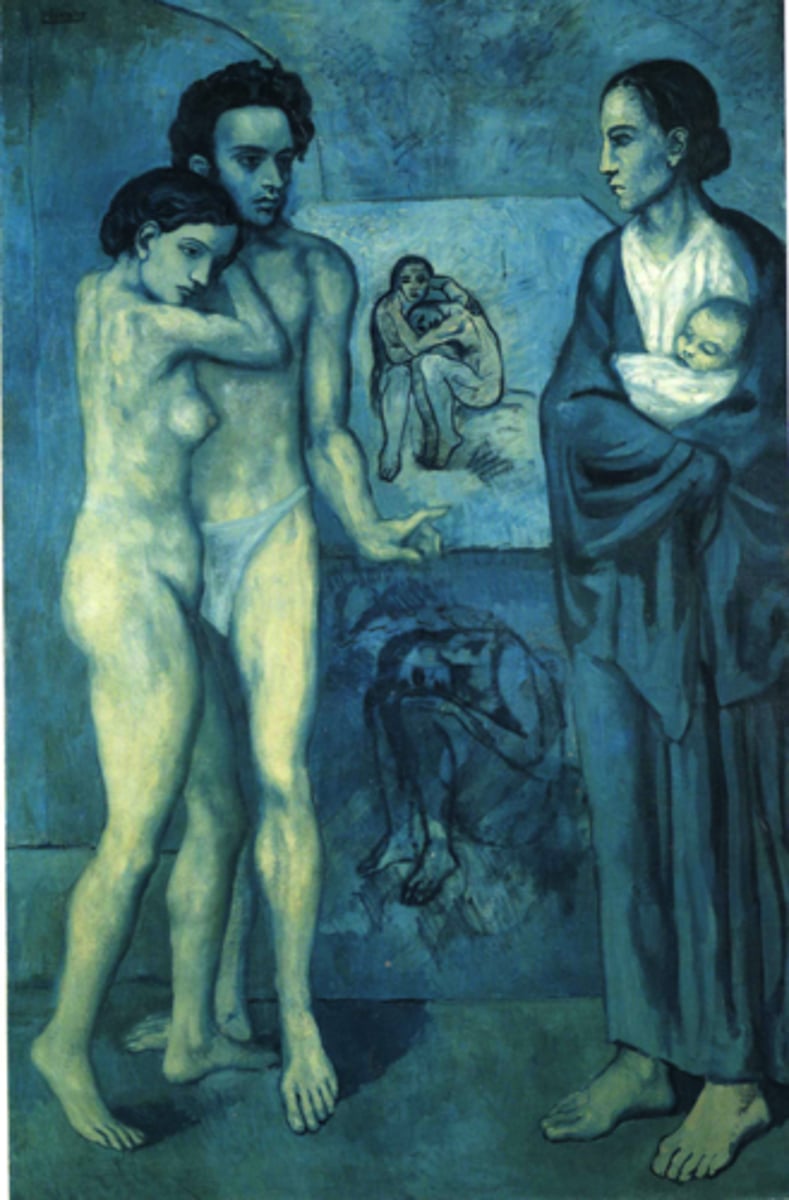
Pablo Picasso, La Vie (Life)
- blue period
- blue the sadness, over the suicide of his friend
- he is poor and loses his friend
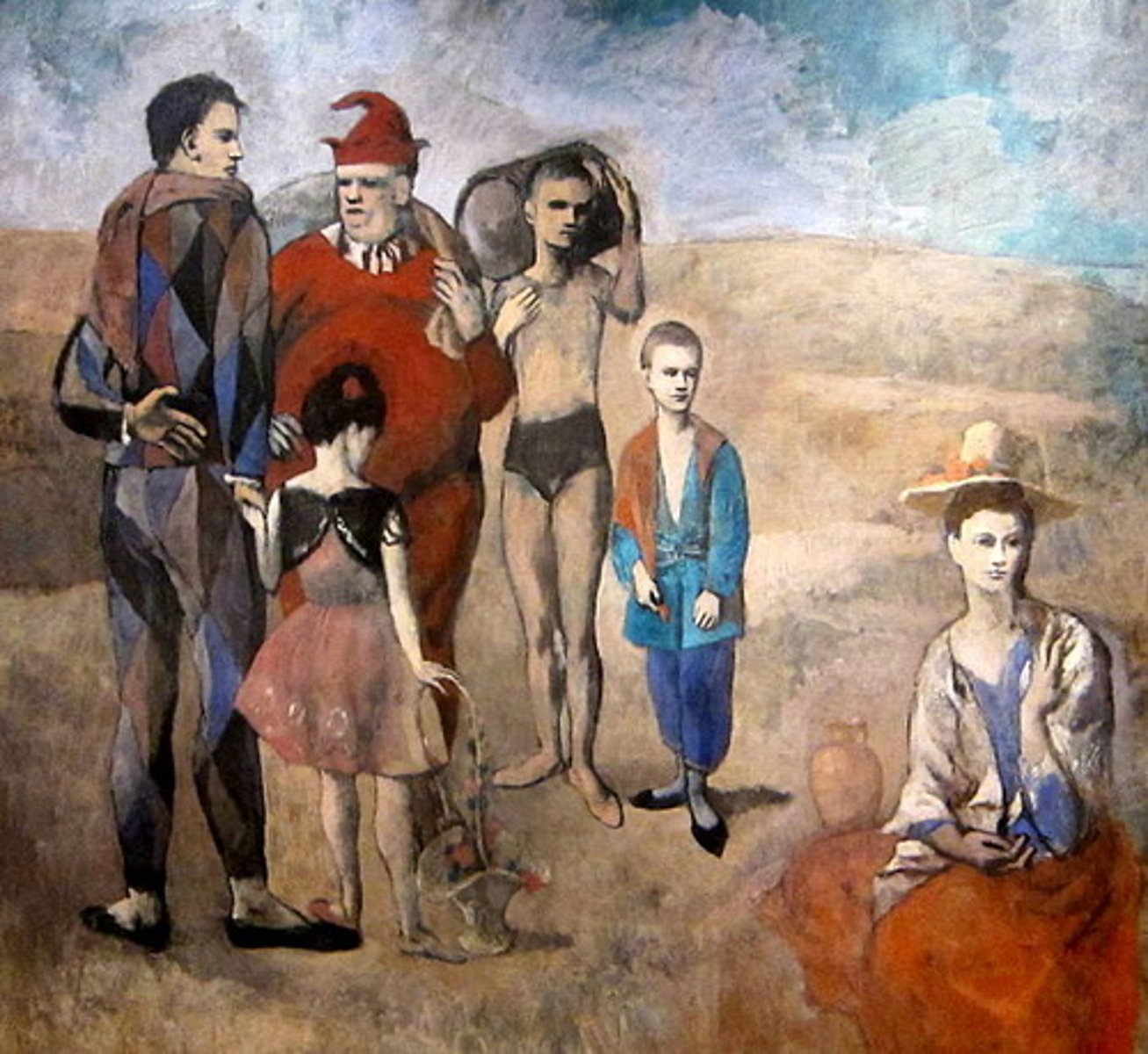
Picasso Rose Period
- pink color palette
- he settled fulltime in paris, was happy again, used delicate pinks and earth colors, obsessed with circus performers, sentimental
- shows buskers, clowns, traveling street performers in Paris
- faces are friends of Picasso from Montmartre neighborhood
- Toulouse-Lautrec, Degas, and Seurat subject matter
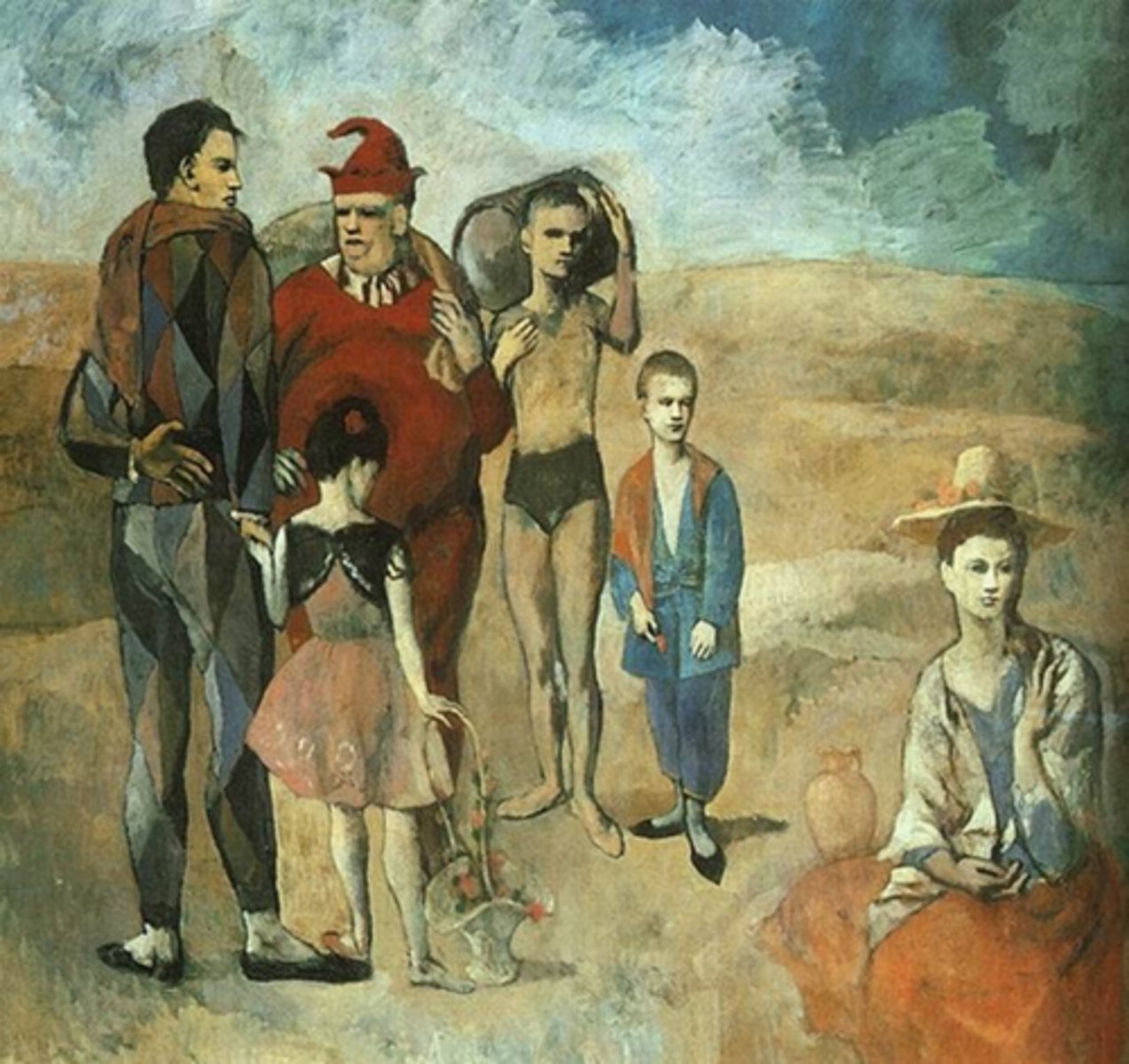
Pablo Picasso, Family of Saltimbanques
- rose period
- lightening of his mood, appreciation
- his past, his friend's faces
- mysterious, reminiscent of his time in Spain
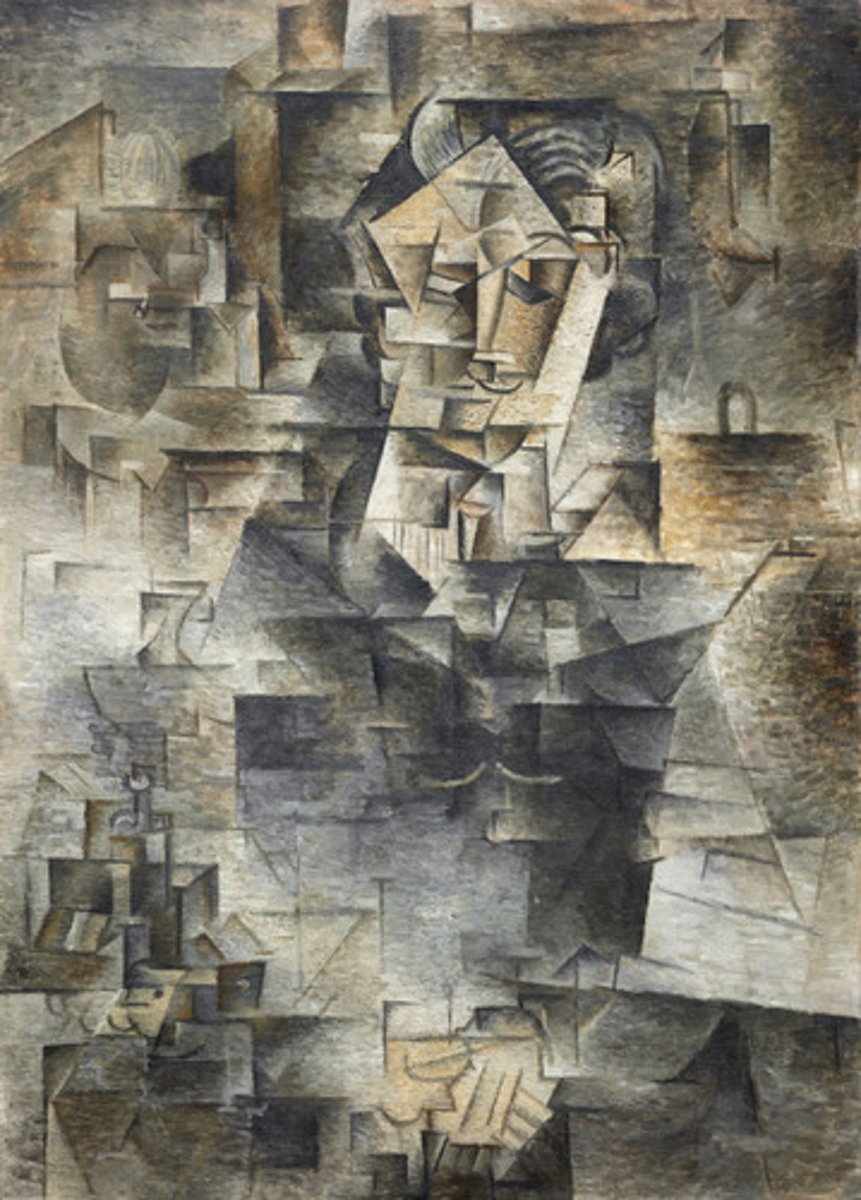
Analytic Cubism
- the first phase of Cubism, developed jointly by Pablo Picasso and Georges Braque, in which the artists analyzed form from every possible vantage point to combine the various views into one pictorial whole
- borrowed idea from Cezanne
- artists try to represent time
- subject matter: nudes and portraits
- brown, neutral colors
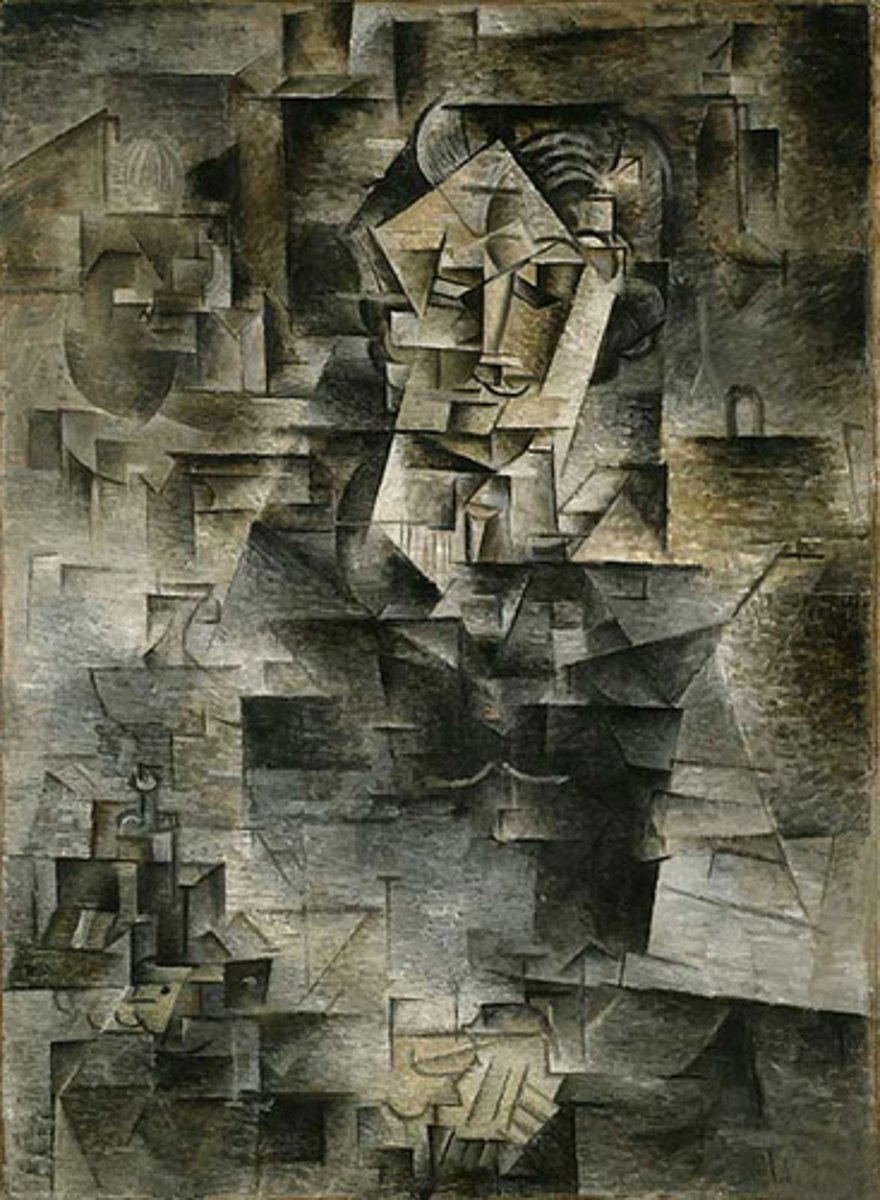
Pablo Picasso, Portrait of Daniel-Henry Kahnweiler
- analytic cubism
- portrait of art dealer
- eliminating traditional linear perspective
- fracturing space and time, from aside, above, and below
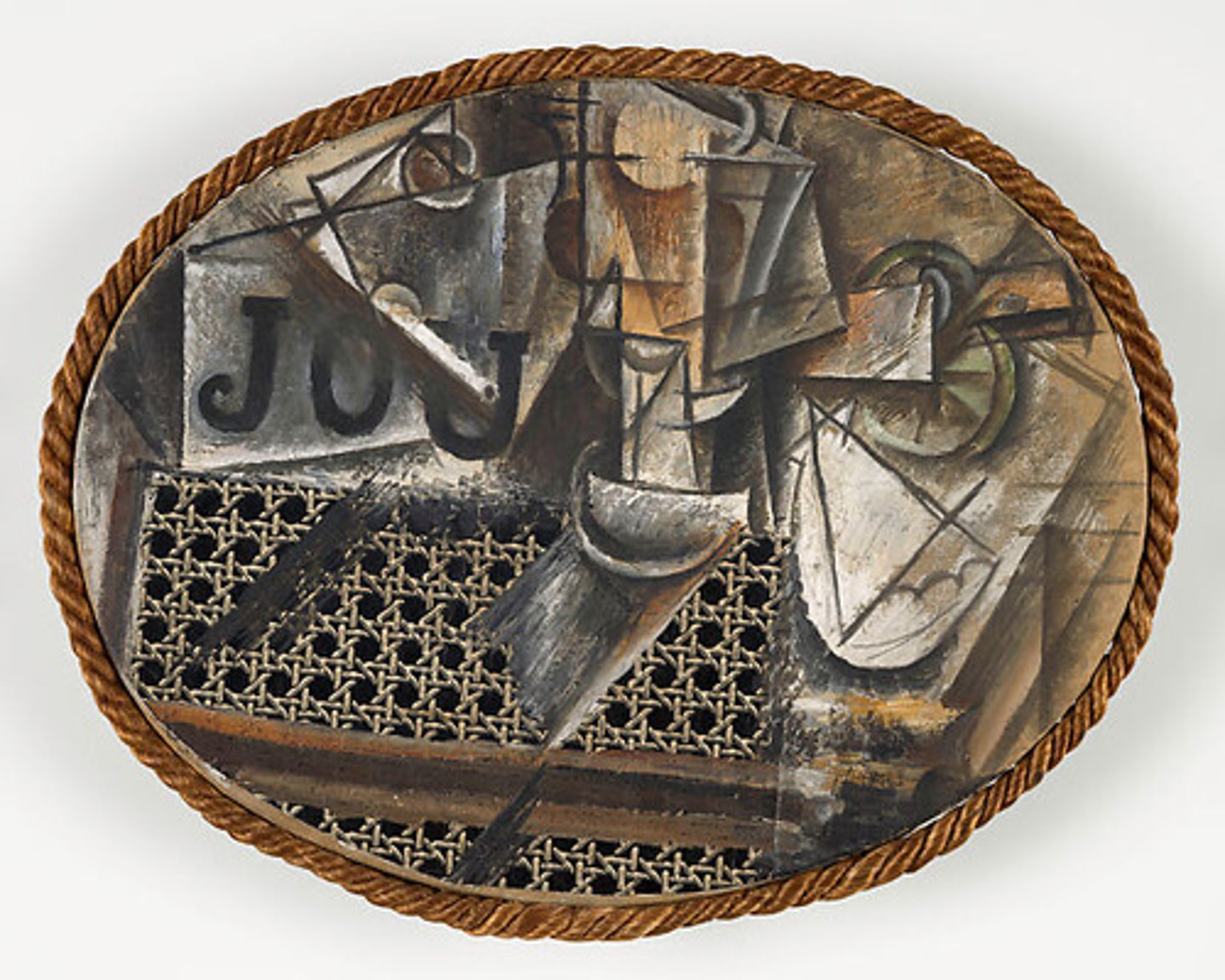
Synthetic Cubism
- later phase of Cubism, in which paintings and drawings were constructed from objects and shapes cut from paper or other materials to represent parts of a subject, in order to engage the viewer with pictorial issues, such as figuration, realism, and abstraction.
- collage
- time through multiple viewpoints
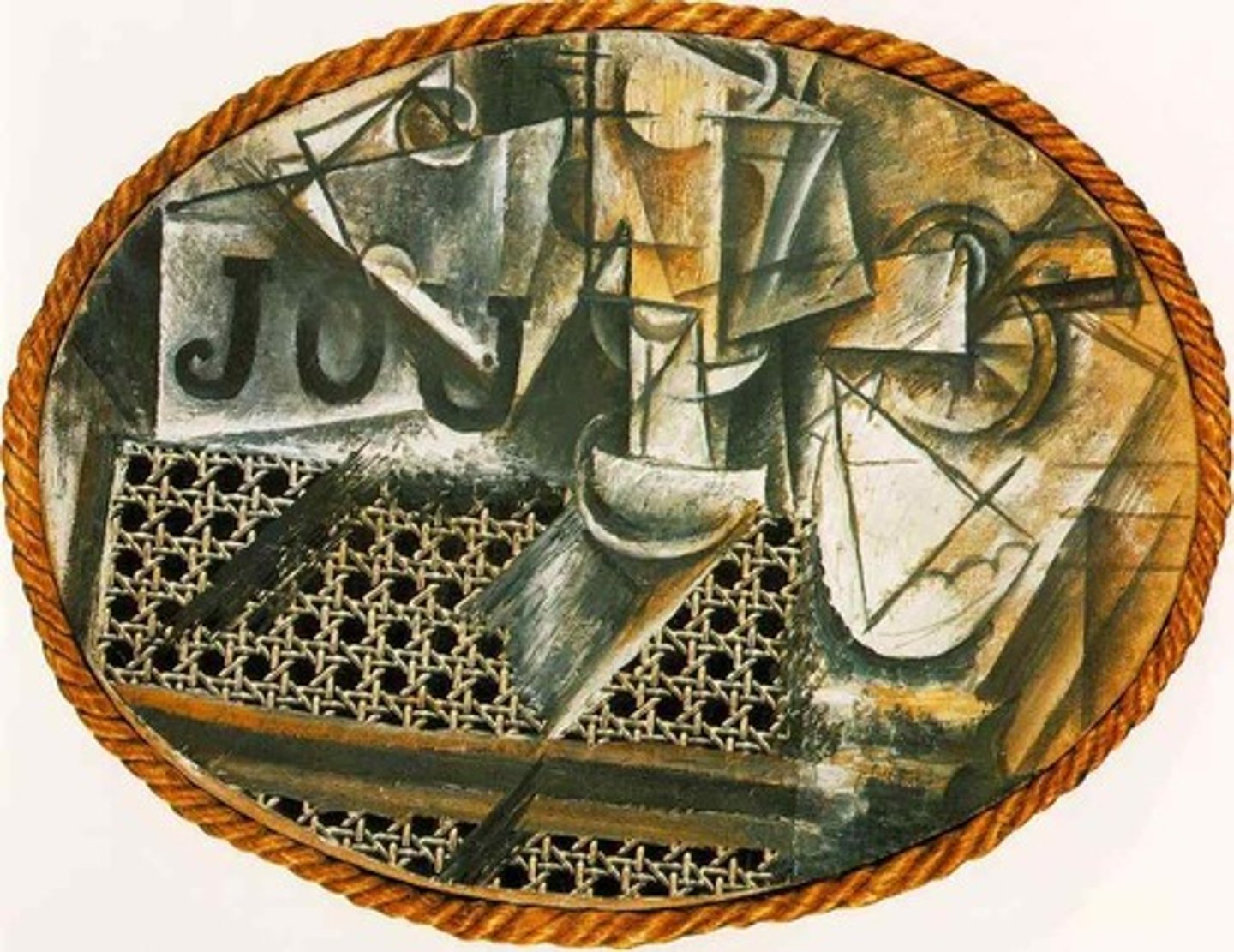
Still Life with Chair Caning by Pablo Picasso
- synthetic cubism
- breaking apart space and time
- synthesizes and brings together
- breaks linear perspective but reimagines it
- bringing on a new way of looking, many viewpoints at the same time
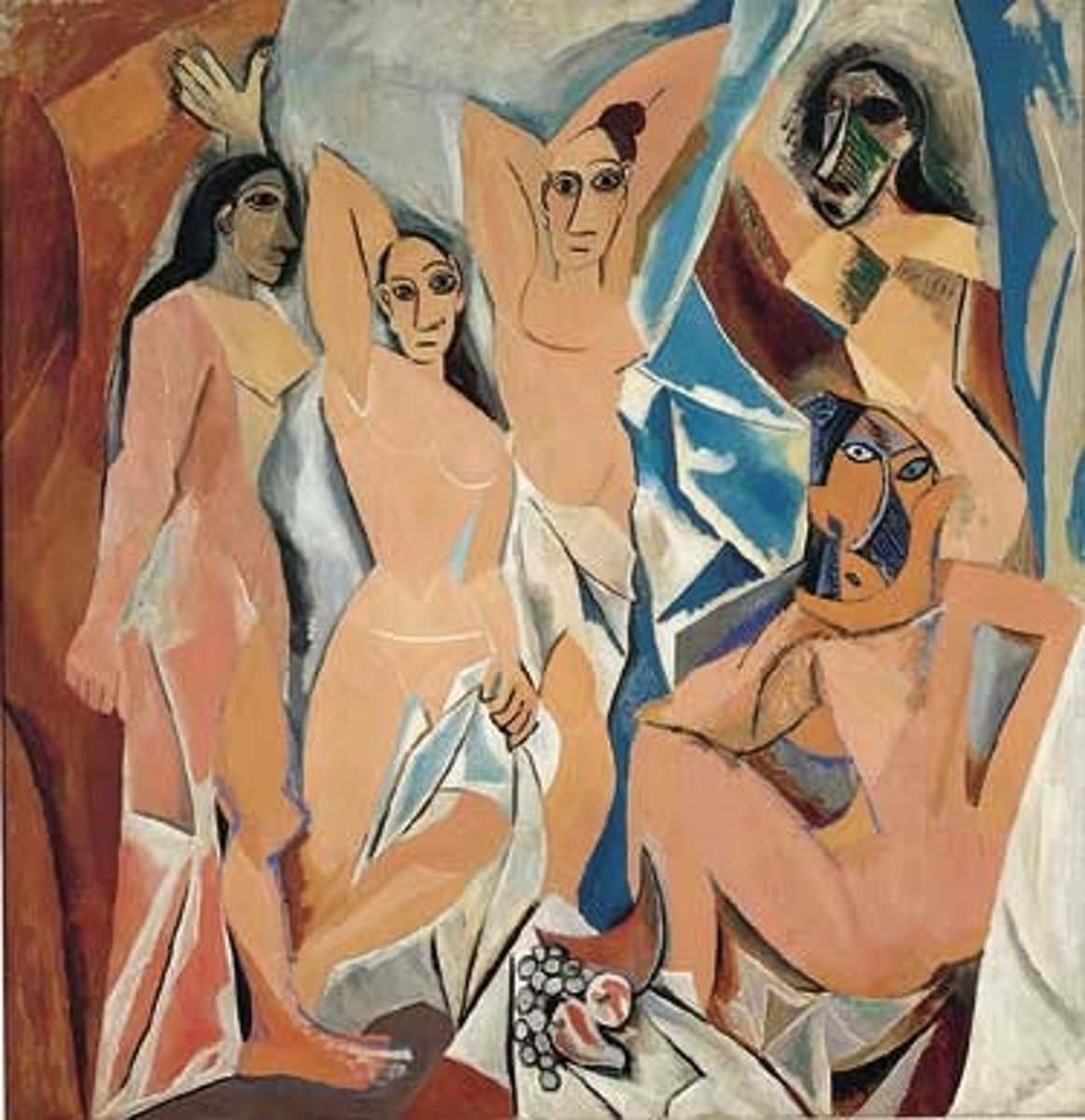
Les Demoiselles d'Avignon by Pablo Picasso
- no movement, before Cubism
- woman brothels in Spain, Barcelona
- African mask influence borrowed by French
- not idealized nude female body
- unnerving, not glamorous, confrontational women
- using elements of another culture to create idea of sexuality/savagery
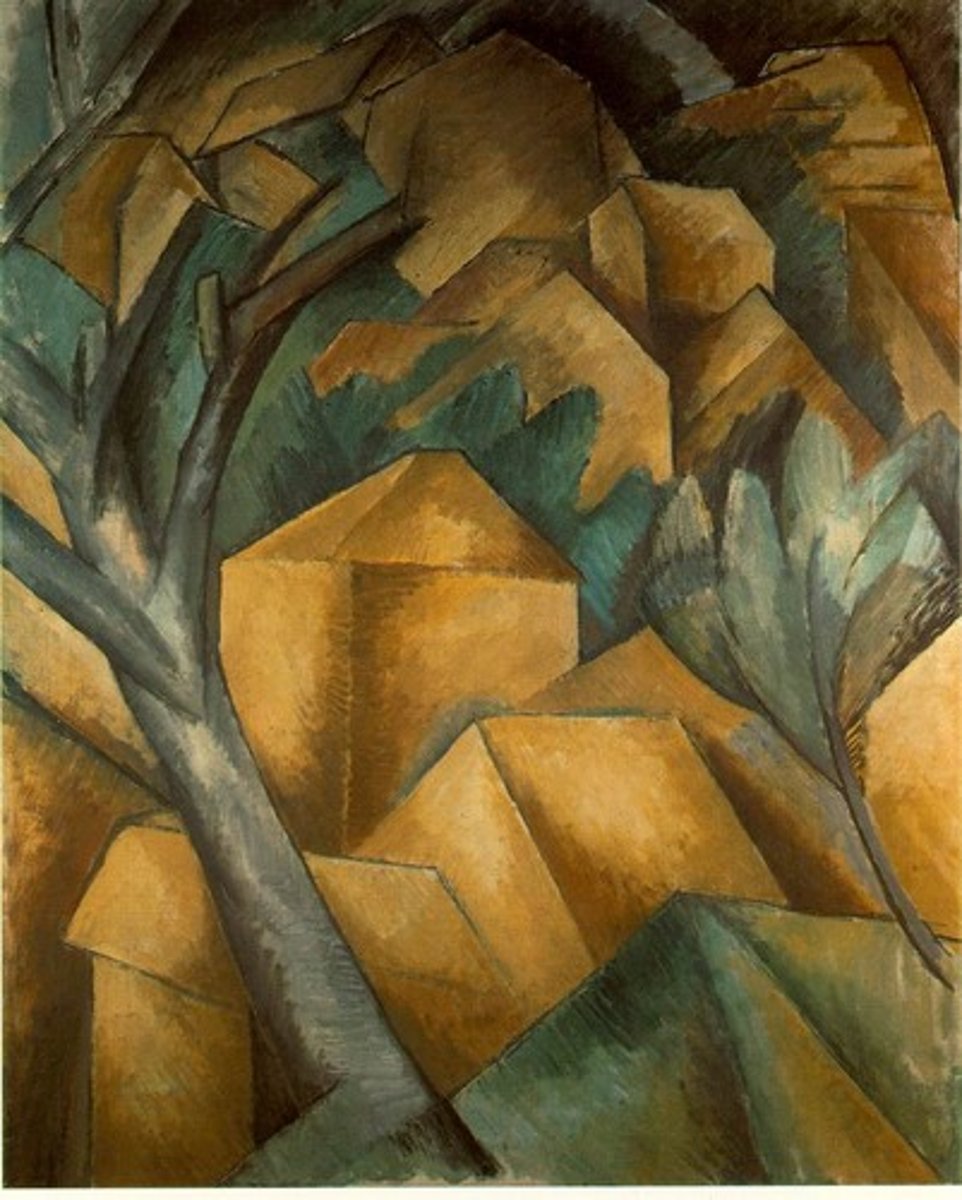
Houses at L'Estaque by Georges Braque
- cubist
- Cezanne influence, south of France where cezanne lived
- Braque was fauves and then cubist
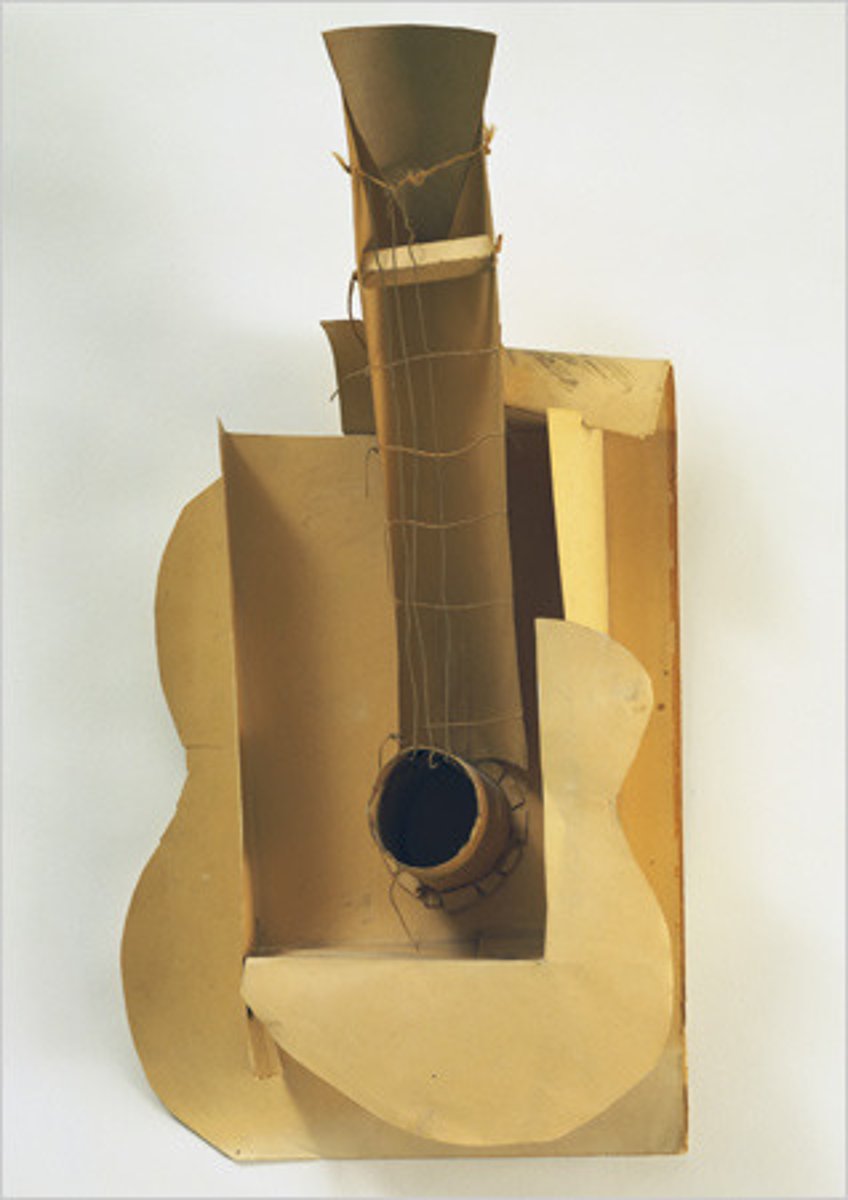
Maquette for Guitar by Pablo Picasso
- cubist
- cardgoard, string, wire
- not an oil painting, not traditional sculptural, dissenagrate
- making a 3d painting, breaking apart forms
- making an artwork out of everyday materials, radical
Futurism
- balla, boccioni, carra, and severini
- movement in modern art that grew out of cubism. Artists used implied motion by shifting planes and having multiple viewpoints of the subject. They strived to show mechanical as well as natural motion and speed. The beginning of the machine age is what inspired these artists. Frank Stella and Giacomo Balla were futurists.
- group wanted to make social change
- futurist Manifestos attacked museums, academia and traditional forms of Italian art and culture
- technology, speed, youth & violence were their themes & passions, saw as worthy subject matter
- Believed world is constant movement; art conveys changes object undergoes during movement
- inspired by Cubism, but believed it too static
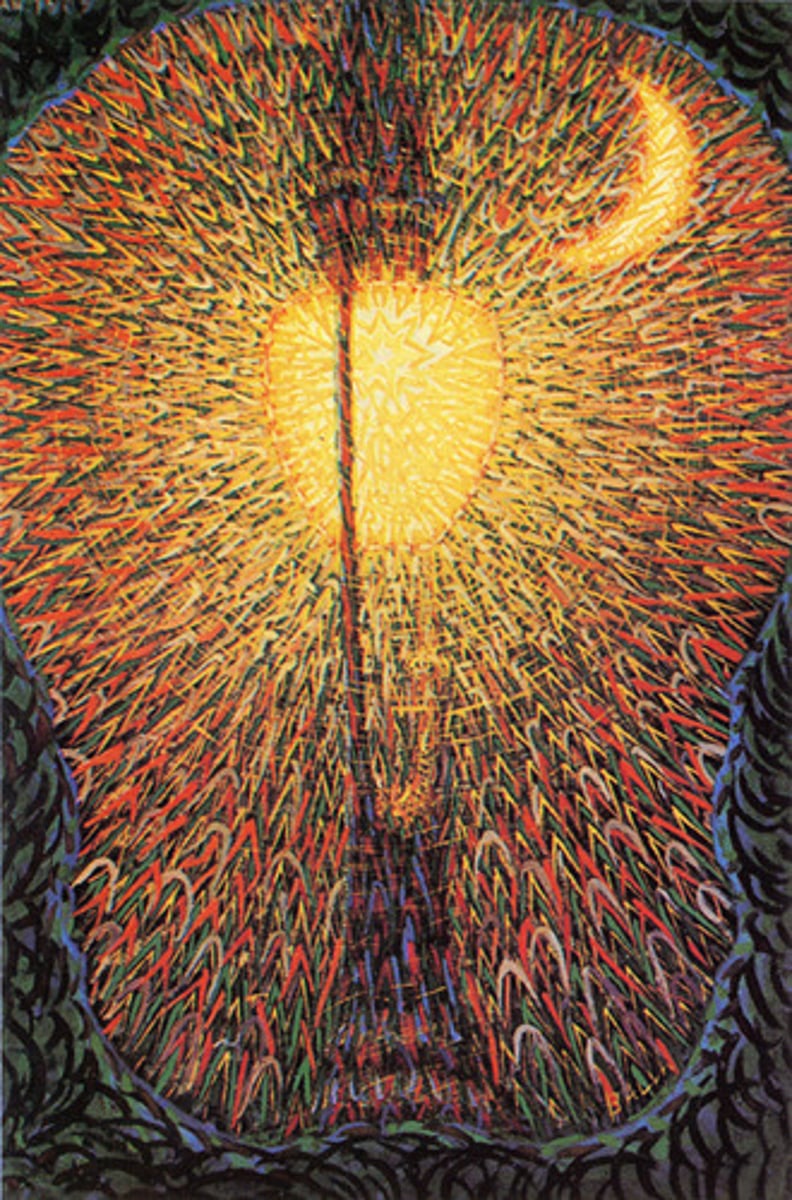
Street Light by Giocomo Balla
- futurist
- neo-impressionist influence
- importance of technology, electric street light
- light surpasses light of moon
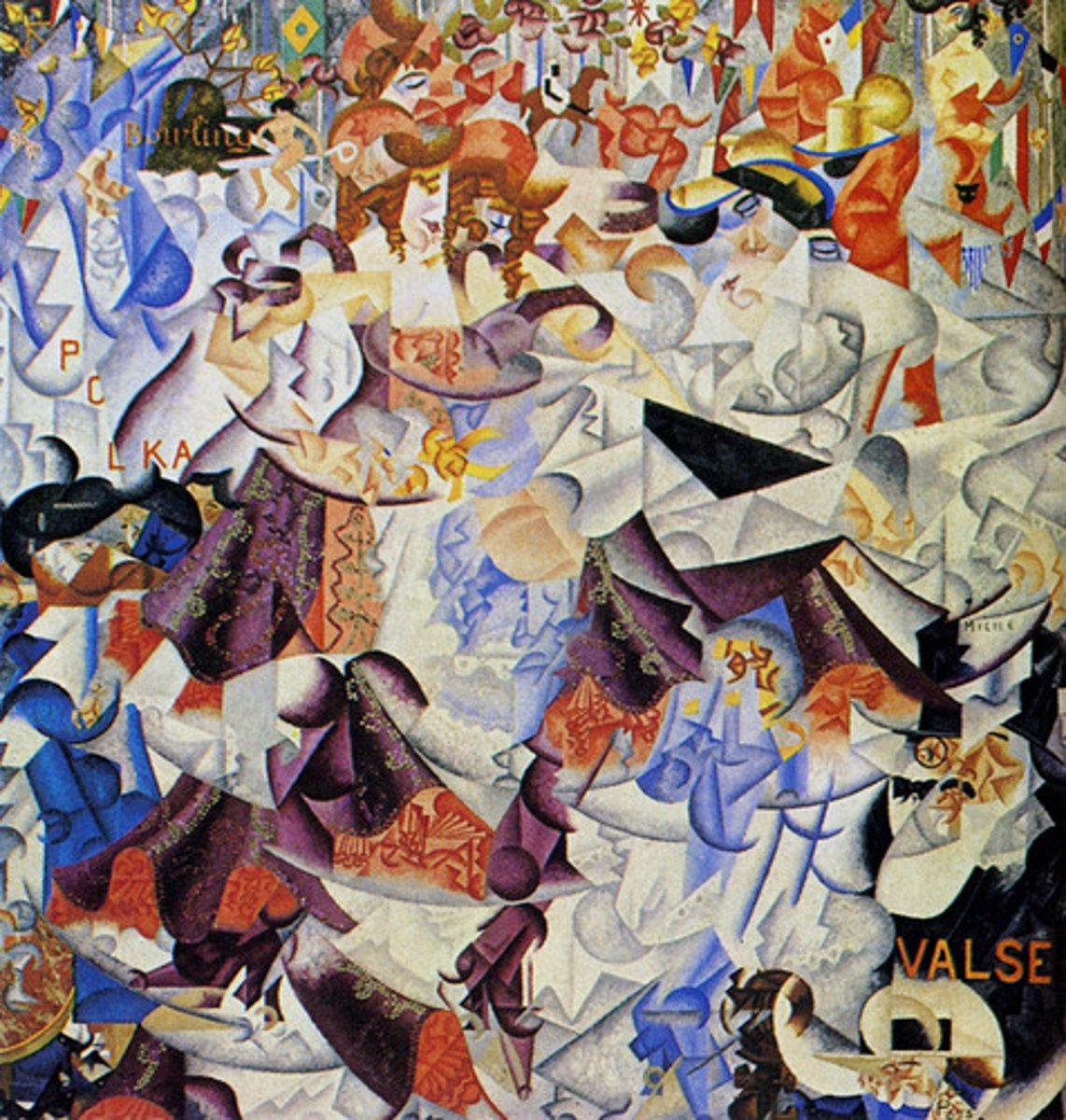
Dynamic Hieroglyphic of the Bal Tabarin by Gino Severini
- futurism
- subject: dancers, relationship to leisure, renior
- futurist because its setting things into motion, fractured, influenced by cubist but be more colorful and motion
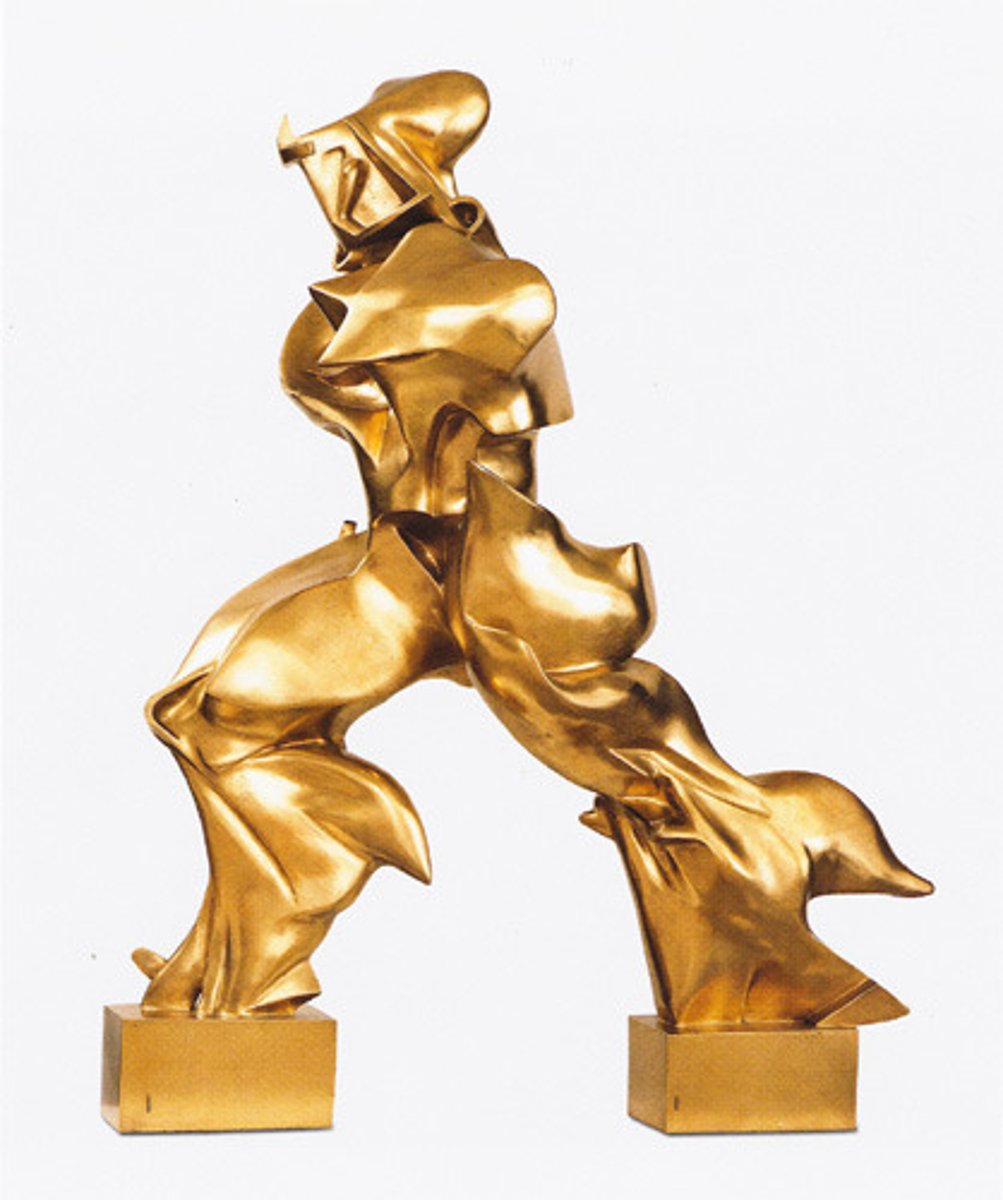
Unique forms of continuity in space by Umberto Boccioni
- futurism
- representing human power, human body is machine
- form in space
- power and motion and change makes it futurist
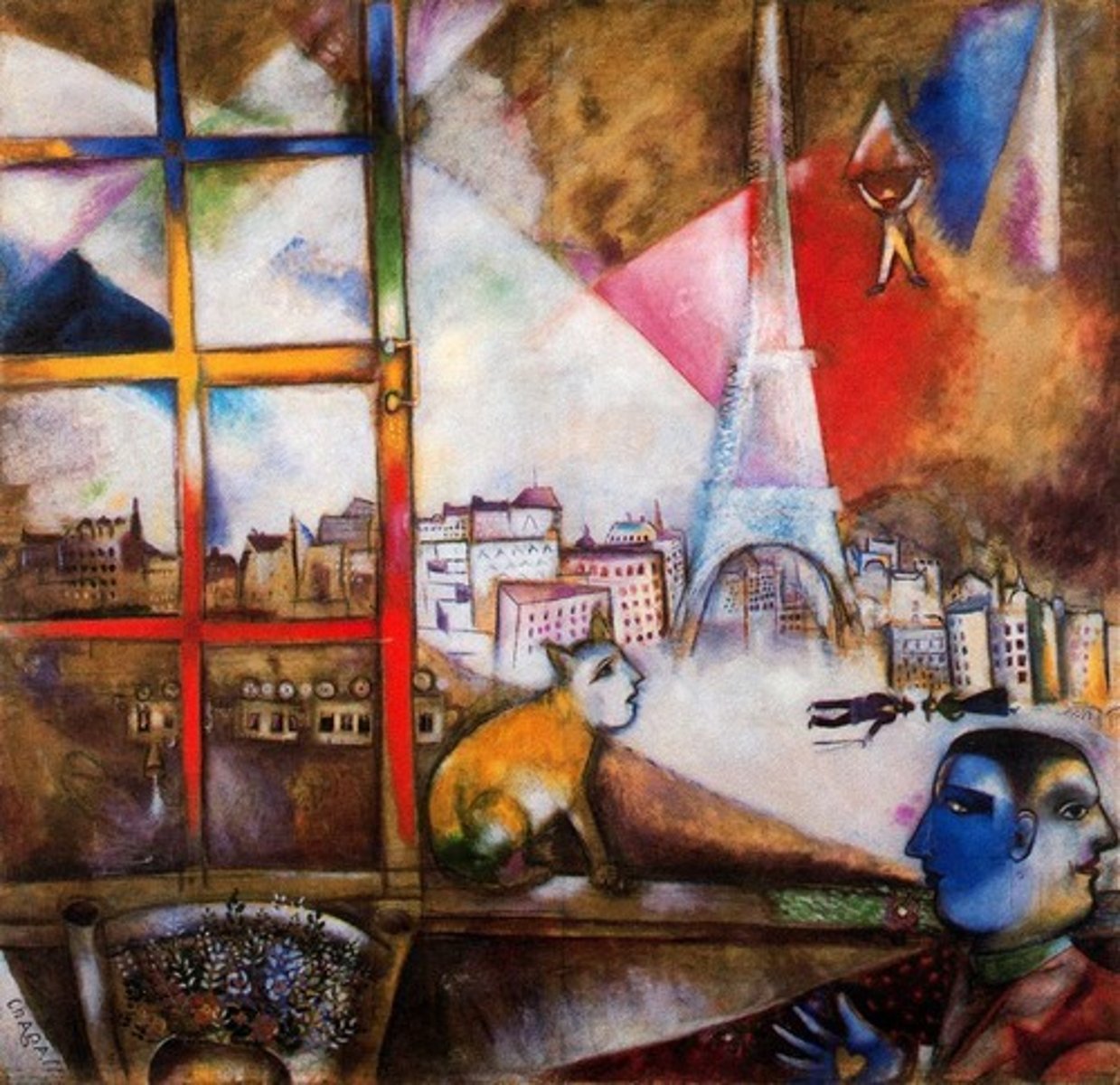
Paris Through the Window by Marc Chagall
- no specific movement
- inspired by Cubism
- Chagall combines tradition/rural Russia with new age, jewish heritage
- Chagall with his wife
- cat references Jewish folklore, sinners who die return as cats and haunt family
- first parachutist shown
- Eiffel tower
- Jewish Hasidic clothed people hovering and flying
- city of Paris morphs into a memory/upside down, incorporates elements from his previous life, memory of the past
- narrative, telling a story symbolically
Metaphysical Art
- Giorgio de Chirico, Carlo Carra
- beyond the real
- nature of time and being
- inspired by Symbolism, dreamlike spaces
- depicts timeless atmosphere using Classical and Renaissance architecture and statues
- pairing unlikely elements together, juxtaposition, to create sense of unease

The Meloncholy and Mystery of a Street by Giorgio de Chirico
- Metaphysical art
- not real, uncomfortable other space, outside of reality
- uses image of empty square, columns of buildings, juxtaposition of unlikely things to create new meanings
- ominous
- child-like, silhouette of girl creates tension between unlikely things
Russian Avant-Garde/ Constructivism
- Lissitzky, Malevich, Rodchenko, Tatlin
- rise of Communist party, art should serve the revolution and new Soviet system
- truth to materials, ie wood should look like wood
- collage using photos, photomontage
- influenced by Cubism
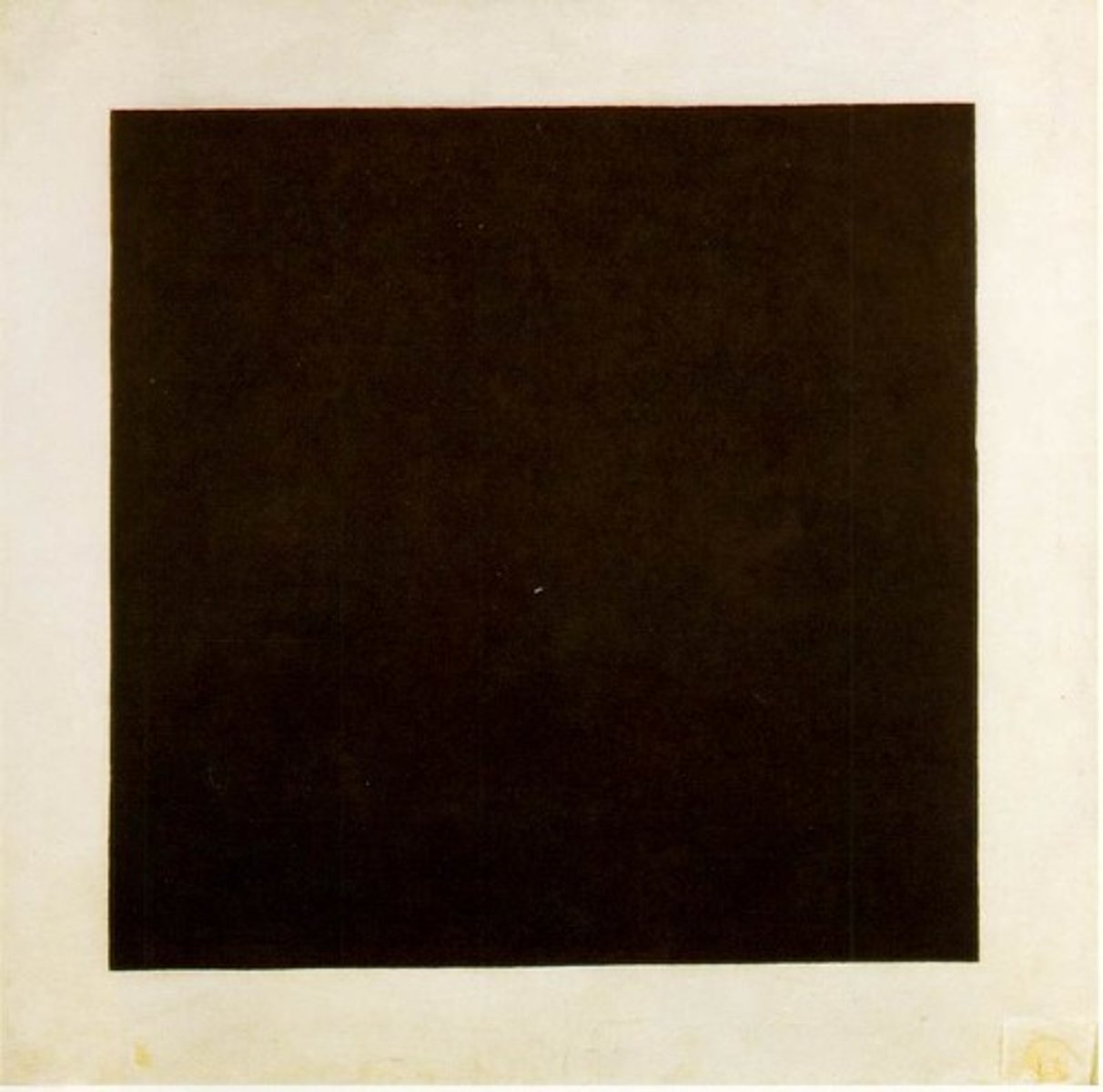
Black Square by Kazimir Malevich
- russian avant garde, constructivism
- square demonstrates a painting can exist without representation of the physical world
- how to show spirituality without showing typical figures that we see in Renaissance; get away from direct reference
- breaking things down to the barest form, the zero of form
- space, nothingness
- white background is the void beyond
- absence of references
- Malevich hung his black square in the place in a Russian orthodox household where another object of veneration would be (in the corner, ceiling), like an altar; very controversial to do that
- suprematism, an abstract art movement pioneered by Kazimir Malevich in Russia around 1913, focused on the "supremacy of pure feeling or perception" in art
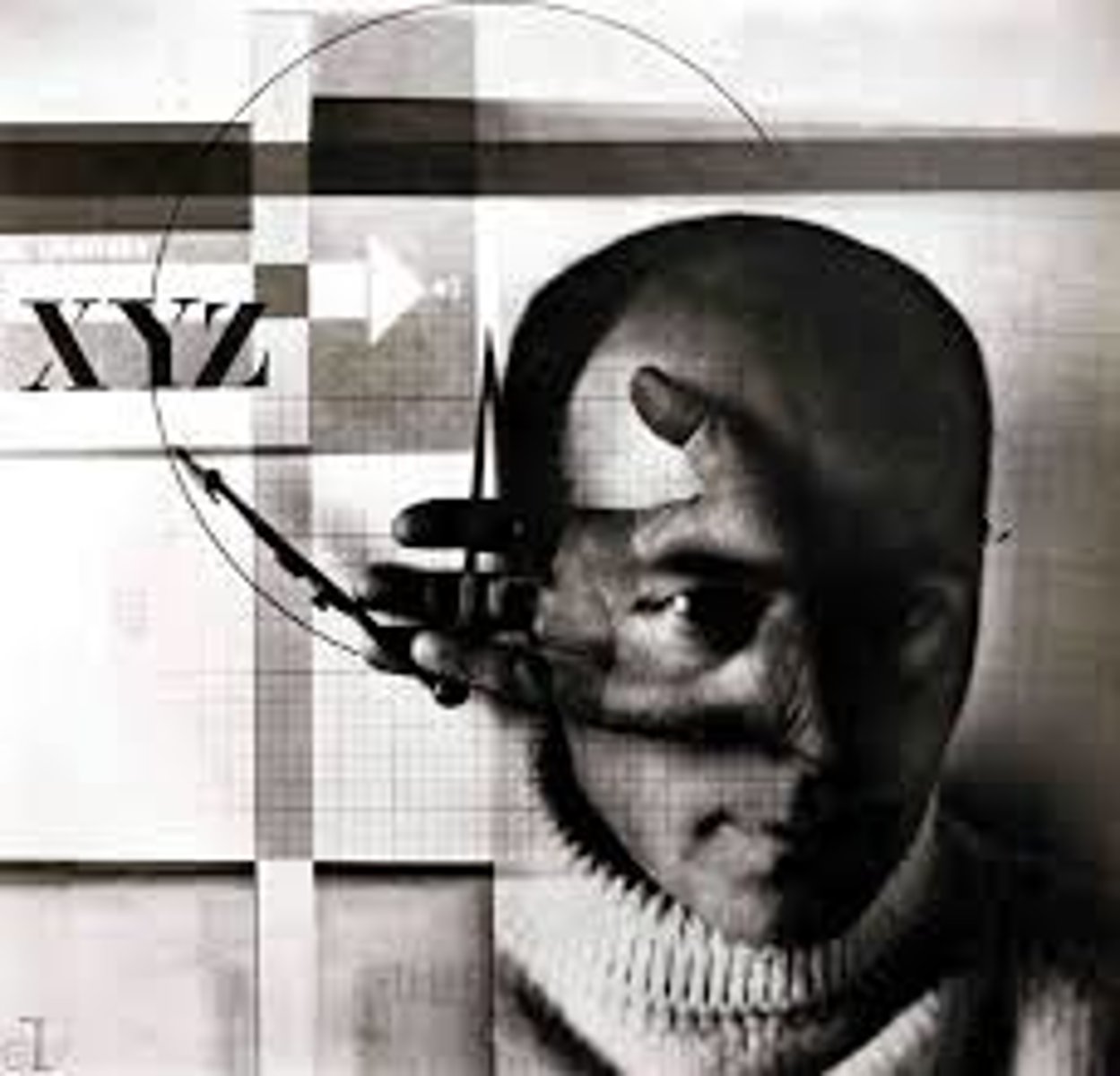
El Lissitzky, The Constructor (Self-Portrait)
- Russian avant garde, constructivism
- photographs himself and superimposes hand of engineer with graph paper and compass, joins them in self-portrait
- the mind and hand go together to make art, represents himself as a maker
- technology is the new way of expressing the revolution
- artist is an engineer and construct-er, not a painter
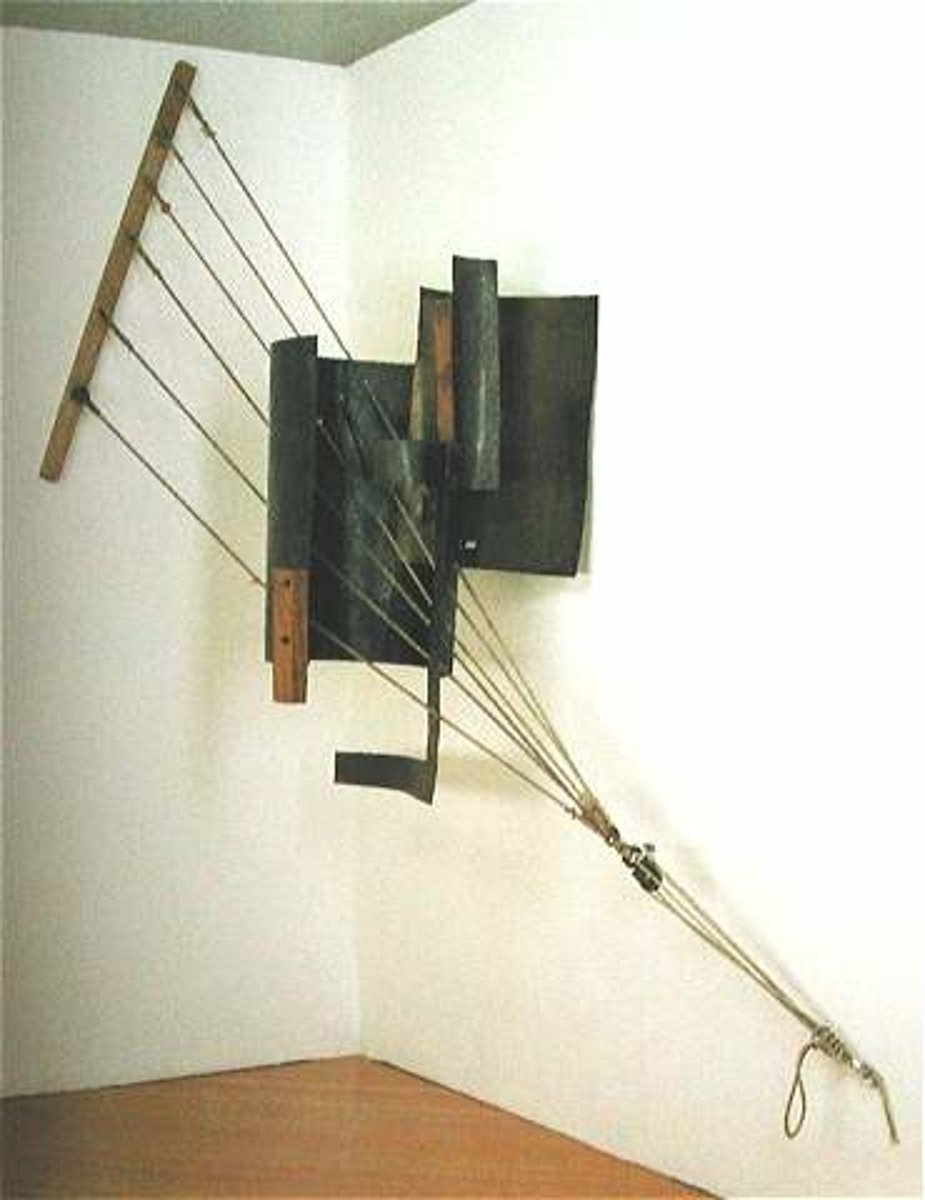
Vladimir Tatlin, Counter-Relief
- russian avant garde, constructivism
- materials; everyday metal, rope
- each material has its own structural laws, the artist shouldn't try to make it something else; building from what he has
- getting away from oil painting on a wall, more engaging the space that its in
-beginning of assemblage art, taking made things and putting them together to make something new
- Tatlin took inspo from some of Picasso's sculptures
- wants the truth of the materials, let the rope be rope, let the wood be wood: true to materials
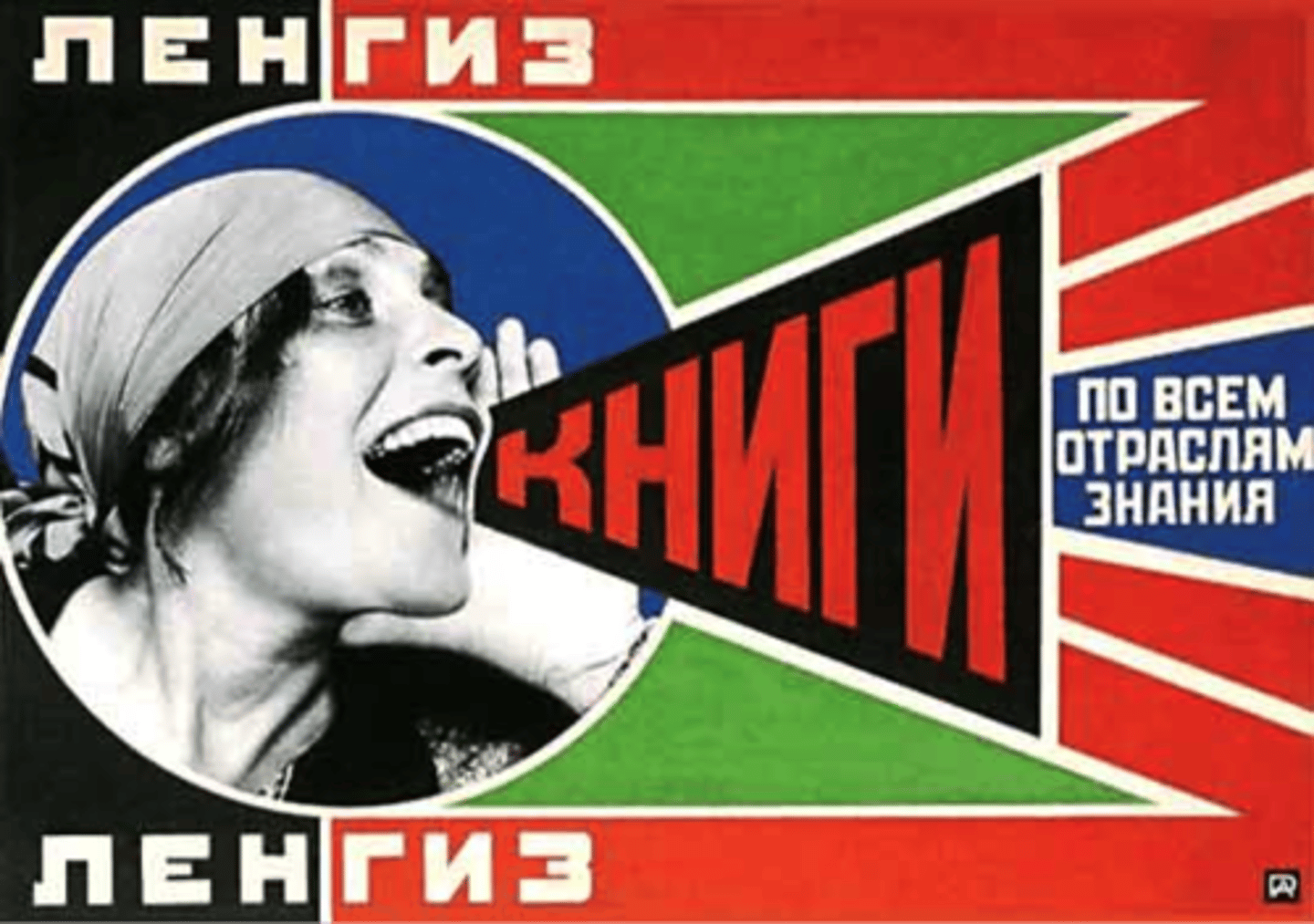
Aleksandr Rodchenko, Untitled advertising poster
- russian avant garde, constructivism
- art can serve the revolution and new society/government
- graphic poster for ad, she is shouting out to buy these books
- radical, she is participating and talking about importance of literacy; workers should unite
- photo montage
-lithographic design
- representative member of youth encourages comrades, new Soviet ideal